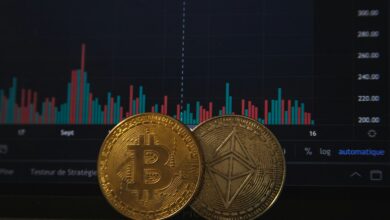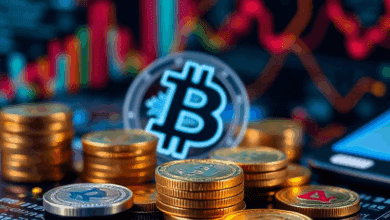Digital gold – cryptocurrency store of value

Allocating assets into bitcoin presents a compelling alternative to traditional safe havens like gold for preserving purchasing power amid rising inflation. Unlike fiat currencies susceptible to devaluation, bitcoin’s fixed supply and decentralized nature offer a robust mechanism for shielding wealth against monetary dilution.
Historically, gold has served as the benchmark for long-term preservation of capital during economic uncertainty. However, increasing digitization and regulatory clarity have elevated bitcoin’s role as an innovative reserve asset that combines scarcity with ease of transferability. This evolution challenges conventional perspectives on hedging strategies within diversified portfolios.
Empirical data from recent market cycles demonstrates bitcoin’s potential to maintain real worth over extended periods, often outperforming traditional commodities in risk-adjusted returns. Investors focused on sustaining their financial legacy must consider integrating this digital asset alongside physical bullion to optimize protection against unpredictable macroeconomic shifts.
Digital gold: cryptocurrency store of value [Digital Finance digital-finance]
For investors seeking a hedge against inflation and currency devaluation, bitcoin presents a compelling alternative to traditional precious metals due to its fixed supply and decentralized issuance. Unlike gold, which is subject to physical extraction limits and geopolitical influences, this asset operates on a blockchain protocol that guarantees scarcity through algorithmic issuance capped at 21 million units. This deterministic supply schedule enhances predictability and long-term preservation of purchasing power amid expanding monetary bases worldwide.
The efficacy of this electronic commodity as an inflation-resistant instrument has been observed in multiple macroeconomic environments. During periods of aggressive fiat money printing by central banks, such as post-2020 pandemic fiscal stimuli, the network’s limited token emission contrasted sharply with rising consumer price indices, supporting its role as a refuge for capital retention. Additionally, transaction transparency and censorship resistance further reinforce its suitability for safeguarding wealth across jurisdictions with unstable governance frameworks.
Technical Foundations and Market Dynamics
The underlying architecture employs proof-of-work consensus mechanisms ensuring security and immutability of ledger entries, which underpin trustless verification without reliance on centralized authorities. This technical robustness contributes significantly to maintaining integrity over time, an attribute traditionally associated with tangible assets like bullion. Moreover, advanced cryptographic methods protect ownership rights while enabling seamless global transfers without intermediaries, reducing counterparty risks common in conventional asset custody.
Comparative analysis reveals distinct advantages when juxtaposed with physical reserves. While gold storage entails logistical costs including vaulting and insurance premiums, the digital alternative requires only secure private key management solutions, ranging from hardware wallets to multisignature schemes. Furthermore, liquidity depth on major exchanges permits efficient entry and exit strategies aligned with portfolio diversification goals. Price volatility remains higher relative to precious metals; however, increasing adoption by institutional participants demonstrates growing confidence in its maturity as a financial instrument.
Empirical data from recent bear markets illustrates resilience where traditional equities faltered sharply; bitcoin exhibited partial decoupling from systemic shocks due to unique demand drivers rooted in technology adoption cycles and monetary policy shifts. Regulatory clarity emerging across jurisdictions enhances market transparency and investor protections without compromising decentralized principles intrinsic to the protocol design. These developments reduce uncertainty factors previously impeding broader acceptance among conservative capital allocators focused on capital preservation objectives.
Strategically integrating this form of digital asset into diversified portfolios necessitates consideration of risk tolerance levels alongside correlation profiles relative to other asset classes. Its deflationary nature contrasts fiat currency inflation tendencies and complements commodities exposure by offering uncorrelated return streams over extended horizons. Continuous monitoring of network health indicators such as hash rate trends and node distribution provides additional insights into sustainability prospects amidst evolving competitive landscapes involving alternative programmable stores of worth.
Comparing Crypto With Gold
For investors seeking an effective hedge against economic uncertainty and inflationary pressures, both bitcoin and physical gold present compelling alternatives to fiat assets. Gold has historically demonstrated resilience in preserving purchasing power over centuries, supported by its tangible nature and limited supply. Conversely, bitcoin’s algorithmically capped issuance at 21 million coins offers a mathematically enforced scarcity that mimics the finite availability of precious metals.
Bitcoin’s decentralized protocol ensures censorship resistance and divisibility, facilitating seamless transferability across borders without reliance on intermediaries. This contrasts with gold’s logistical constraints related to storage, transportation, and verification costs. Institutional adoption of bitcoin as a diversification tool has accelerated since 2020, evidenced by portfolio allocations from firms such as MicroStrategy and Tesla, highlighting confidence in its potential to act as a modern inflation-resistant asset.
Technical Considerations in Preservation of Wealth
The preservation characteristics of these two assets differ significantly due to their intrinsic properties. Gold’s physical form provides inherent durability against digital risks but exposes holders to theft or degradation without proper custodianship. Bitcoin’s cryptographic foundation leverages blockchain immutability and network security through proof-of-work consensus mechanisms, reducing counterparty risk while introducing technological dependencies like private key management.
Empirical data shows that during periods of heightened inflation–such as the U.S. post-2008 quantitative easing era–gold prices appreciated at an average annual rate of approximately 9%. Comparatively, bitcoin’s performance since inception reflects higher volatility yet exponential growth trajectories; for instance, its price surged over 1,300% between 2017 and late 2020 despite intermittent corrections. Such dynamics position bitcoin as both a speculative asset and potential long-term safeguard against monetary debasement.
Market Dynamics and Regulatory Impact
The liquidity profiles also diverge: gold benefits from established global markets including futures exchanges like COMEX and physical bullion dealers offering immediate settlement options. Bitcoin operates within a rapidly evolving regulatory framework; jurisdictions vary widely in acceptance levels–from outright bans to full integration into financial systems–which influences accessibility and institutional participation. Regulatory clarity is essential for sustained maturation of cryptocurrency markets as reliable hedging instruments.
Case studies highlight how geopolitical tensions can simultaneously boost demand for safe-haven metals while accelerating interest in decentralized alternatives. For example, during the 2022 inflation surge triggered by supply chain disruptions and fiscal stimuli, both assets experienced inflows demonstrating complementary roles rather than direct competition in portfolio strategies focused on risk mitigation.
Volatility Impact On Value
Bitcoin’s price fluctuations significantly affect its capacity for long-term preservation of worth. While its limited supply makes it a potential hedge against inflation, the asset’s high short-term volatility challenges consistent retention of purchasing power. Historical data reveals that Bitcoin’s 30-day rolling volatility often exceeds 60%, compared to traditional safe havens like gold, which typically exhibit volatility under 10%. This disparity complicates its use as a stable reserve of purchasing power in portfolios seeking minimal value erosion.
Inflationary environments increase demand for assets resistant to currency debasement, positioning Bitcoin as an alternative mechanism for safeguarding capital. However, substantial swings – sometimes exceeding 20% intraday – can erode confidence among conservative investors prioritizing stability over speculative gains. Case studies during macroeconomic stress periods, such as early 2021 and late 2023, demonstrate episodes where Bitcoin’s price corrections temporarily negated inflation-hedging benefits, underscoring the necessity for strategic allocation and risk management.
Analyzing Volatility Drivers and Mitigation Strategies
Volatility stems from factors including regulatory announcements, market sentiment shifts, and liquidity constraints inherent to blockchain-based assets. For example, sudden changes in policy within major economies have historically triggered rapid price adjustments. Institutions increasingly integrate derivative instruments like futures and options to hedge exposure effectively, smoothing portfolio risk profiles without sacrificing upside potential. Additionally, diversified holdings combining Bitcoin with less volatile assets enhance overall resilience against abrupt market moves.
The evolving infrastructure supporting this ecosystem contributes to gradual volatility reduction over time. Enhanced exchange transparency, maturation of custodial services, and broader institutional participation strengthen market depth and reduce susceptibility to manipulation. Predictive models leveraging on-chain analytics now enable more accurate forecasting of price movements tied to network activity metrics such as hash rate fluctuations and transaction volumes. Consequently, investors equipped with these analytical tools can better navigate volatility while maintaining strategic focus on long-term capital retention amid shifting economic conditions.
Choosing Stable Cryptocurrencies
Prioritize assets with mechanisms that reduce price volatility and maintain purchasing power over time. Tethered tokens pegged to fiat currencies or commodities often provide a reliable alternative for preserving capital amid market fluctuations. These instruments utilize collateralization strategies or algorithmic protocols designed to align their market quotations closely with underlying reference values.
While Bitcoin remains a prominent hedge against inflation due to its capped supply, stable alternatives offer more predictable liquidity and less susceptibility to speculative swings. Assessing liquidity pools, trading volumes, and governance frameworks is essential when selecting an asset aimed at safeguarding monetary worth within decentralized environments.
Technical Criteria for Stability Assessment
Examine the peg maintenance methods employed by contenders:
- Fiat-backed reserves: Transparency through regular audits enhances trust in tokens backed one-to-one by national currencies.
- Crypto-collateralized models: Over-collateralization with volatile assets introduces complexity but can sustain stability if liquidation protocols are robust.
- Algorithmic stabilization: Supply adjustment algorithms attempt equilibrium without direct collateral; however, historical case studies reveal challenges in maintaining parity under stress scenarios.
The choice between these approaches depends on risk tolerance and institutional confidence in issuer credibility and smart contract security.
A comparative table summarizing key features provides clarity:
An investor must consider regulatory developments impacting these entities, as compliance measures influence long-term viability. For instance, increased scrutiny over fiat-pegged assets demands strict reserve attestations, which can mitigate counterparty risk.
The intersection of economic shifts and technological innovation also informs strategic allocation decisions. Monitoring emergent multi-asset baskets that blend commodity exposure–such as tokenized precious metals–with fiat anchors may enhance preservation efficacy compared to single-peg solutions alone.
This nuanced approach balances the need for a dependable medium of exchange with protection against inflationary pressures, mirroring certain characteristics traditionally associated with physical bullion holdings but adapted for decentralized finance frameworks.
Secure Storage Methods: Strategic Preservation of Bitcoin as a Hedge Against Inflation
Optimal custody solutions for bitcoin demand rigorous cryptographic safeguards combined with user-centric key management protocols to ensure long-term retention and protection. Cold wallets leveraging multisignature schemes and hardware security modules (HSMs) remain the cornerstone for mitigating exposure to cyber threats, while advanced threshold signature technologies provide scalable, decentralized control without single points of failure.
Institutional adoption highlights the necessity of layered defense architectures integrating geographically distributed vaults and air-gapped backup strategies. These frameworks not only preserve asset integrity but also reinforce resilience against regulatory shifts and systemic market volatility linked to inflationary pressures affecting traditional stores like gold.
Future Outlook and Broader Implications
The evolution of custody mechanisms will increasingly intersect with advancements in zero-knowledge proofs and secure multiparty computation, enabling trustless validation without compromising private keys. This technological trajectory underpins bitcoin’s role as a robust hedge by ensuring both liquidity and security amid fluctuating macroeconomic conditions.
Comparatively, unlike physical bullion requiring specialized storage environments, these digital preservation techniques reduce friction costs and enhance transferability across diverse financial ecosystems. As monetary inflation accelerates globally, such innovations position cryptocurrencies as compelling alternatives for capital conservation beyond conventional paradigms.
- Technical integration: Combining hardware wallets with institutional-grade cold storage protocols elevates security postures suitable for large-scale holdings.
- Regulatory alignment: Compliance-driven custodial services incorporating transparent auditing improve market confidence while safeguarding assets from confiscation risks.
- Liquidity considerations: Emerging Layer 2 solutions facilitate rapid settlement without compromising underlying cryptographic guarantees critical for long-term preservation.
The strategic deployment of sophisticated retention methodologies is pivotal in reinforcing bitcoin’s stature as an inflation-resistant asset akin to traditional bullion yet optimized for seamless digital transfer. Forward-looking stakeholders must evaluate emerging technical standards alongside evolving regulatory regimes to safeguard purchasing power effectively over extended horizons.
This approach not only preserves accumulated capital but also catalyzes broader financial innovation by bridging legacy wealth structures with cryptographically secured monetary instruments that redefine hedging in contemporary economic contexts.






